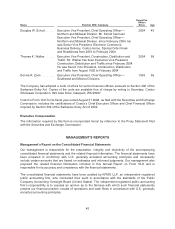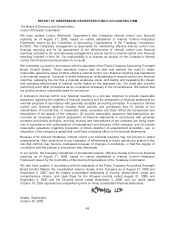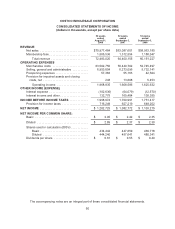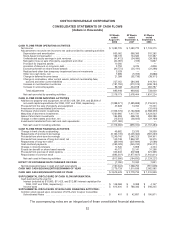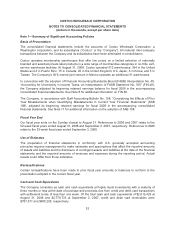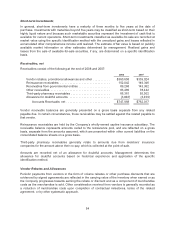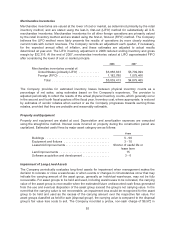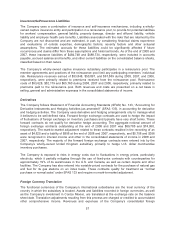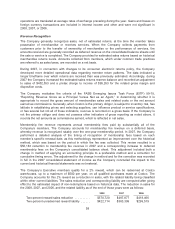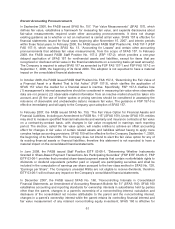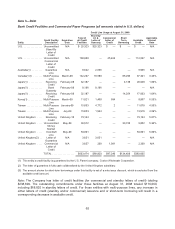Costco 2008 Annual Report Download - page 57
Download and view the complete annual report
Please find page 57 of the 2008 Costco annual report below. You can navigate through the pages in the report by either clicking on the pages listed below, or by using the keyword search tool below to find specific information within the annual report.
Merchandise Inventories
Merchandise inventories are valued at the lower of cost or market, as determined primarily by the retail
inventory method, and are stated using the last-in, first-out (LIFO) method for substantially all U.S.
merchandise inventories. Merchandise inventories for all other foreign operations are primarily valued
by the retail inventory method and are stated using the first-in, first-out (FIFO) method. The Company
believes the LIFO method more fairly presents the results of operations by more closely matching
current costs with current revenues. The Company records an adjustment each quarter, if necessary,
for the expected annual effect of inflation, and these estimates are adjusted to actual results
determined at year-end. The LIFO inventory adjustment in 2008 reduced ending inventory and gross
margin by $32,316. At the end of 2007, merchandise inventories valued at LIFO approximated FIFO
after considering the lower of cost or market principle.
2008 2007
Merchandise inventories consist of:
United States (primarily LIFO) ............. $3,856,633 $3,799,999
Foreign (FIFO) .......................... 1,182,780 1,079,466
Total .............................. $5,039,413 $4,879,465
The Company provides for estimated inventory losses between physical inventory counts as a
percentage of net sales, using estimates based on the Company’s experience. The provision is
adjusted periodically to reflect the results of the actual physical inventory counts, which generally occur
in the second and fourth fiscal quarters of the fiscal year. Inventory cost, where appropriate, is reduced
by estimates of vendor rebates when earned or as the Company progresses towards earning those
rebates, provided that they are probable and reasonably estimable.
Property and Equipment
Property and equipment are stated at cost. Depreciation and amortization expenses are computed
using the straight-line method. Interest costs incurred on property during the construction period are
capitalized. Estimated useful lives by major asset category are as follows:
Years
Buildings ......................................... 5-50
Equipment and fixtures ............................. 3-10
Leasehold improvements ............................ Shorter of useful life or
lease term
Land improvements ................................ 15
Software acquisition and development ................. 3-6
Impairment of Long-Lived Assets
The Company periodically evaluates long-lived assets for impairment when management makes the
decision to relocate or close a warehouse or when events or changes in circumstances occur that may
indicate the carrying amount of the asset group, generally an individual warehouse, may not be fully
recoverable. For asset groups to be held and used, including warehouses to be relocated, the carrying
value of the asset group is recoverable when the estimated future undiscounted cash flows generated
from the use and eventual disposition of the asset group exceed the group’s net carrying value. In the
event that the carrying value is not recoverable, an impairment loss would be recognized for the asset
group to be held and used as the excess of the carrying amount over the respective fair value. For
asset groups classified as held for sale (disposal group), the carrying value is compared to the disposal
group’s fair value less costs to sell. The Company recorded a pretax, non-cash charge of $9,972 in
55


